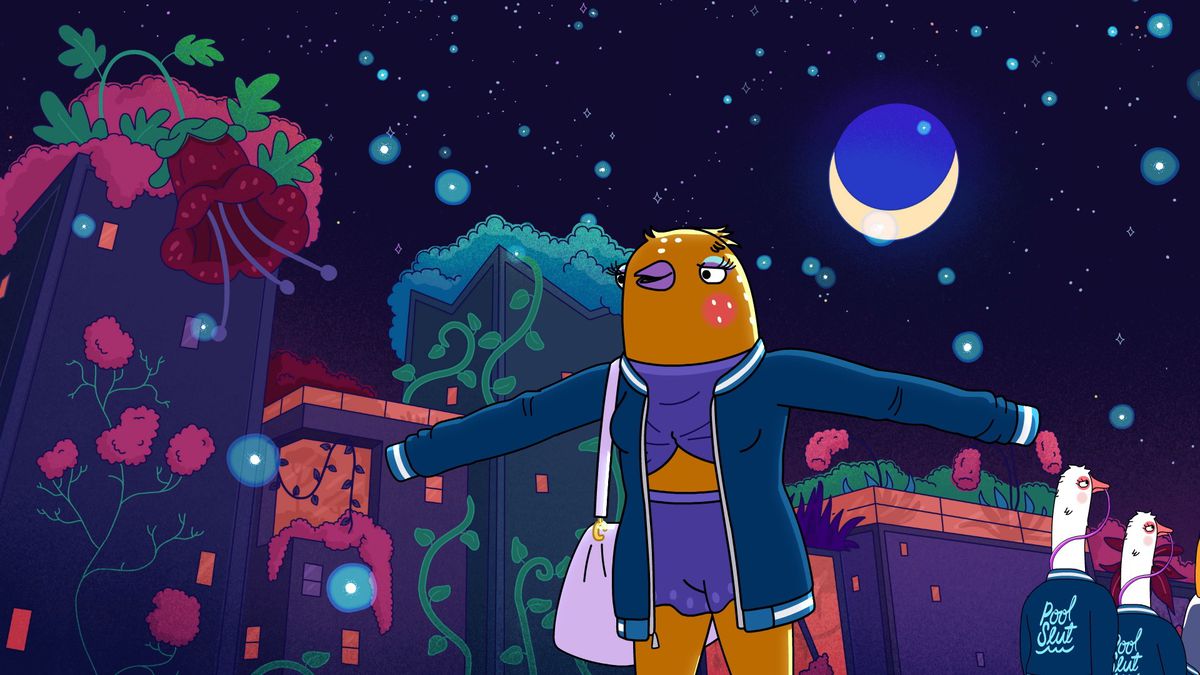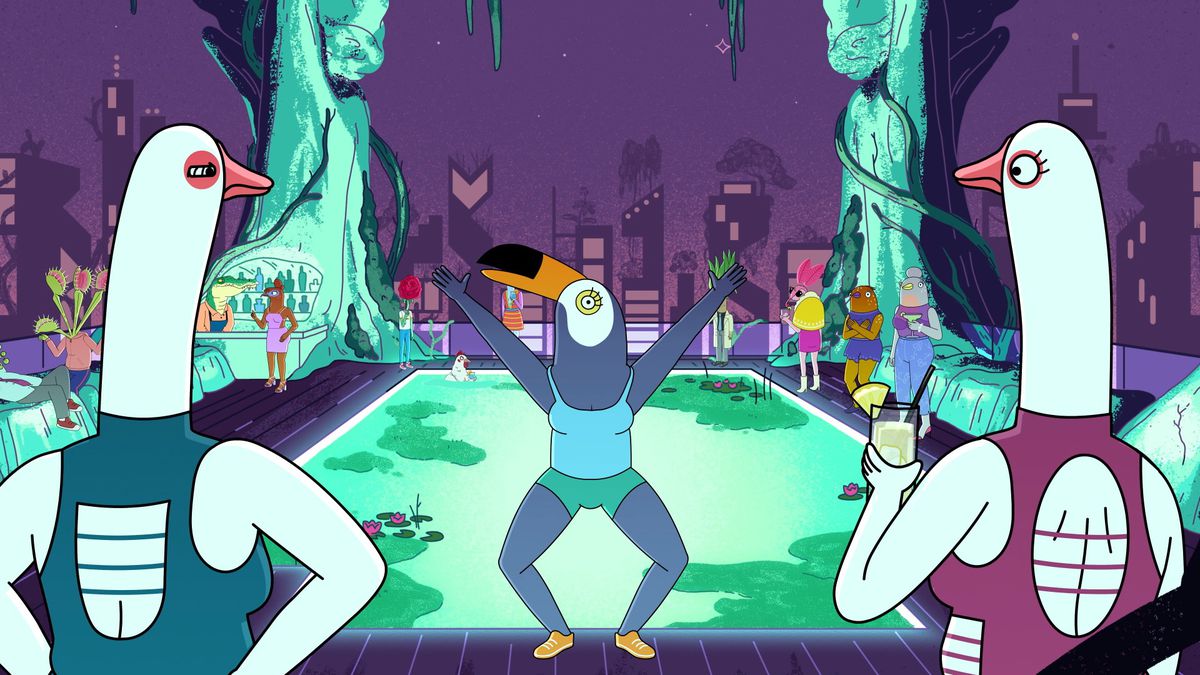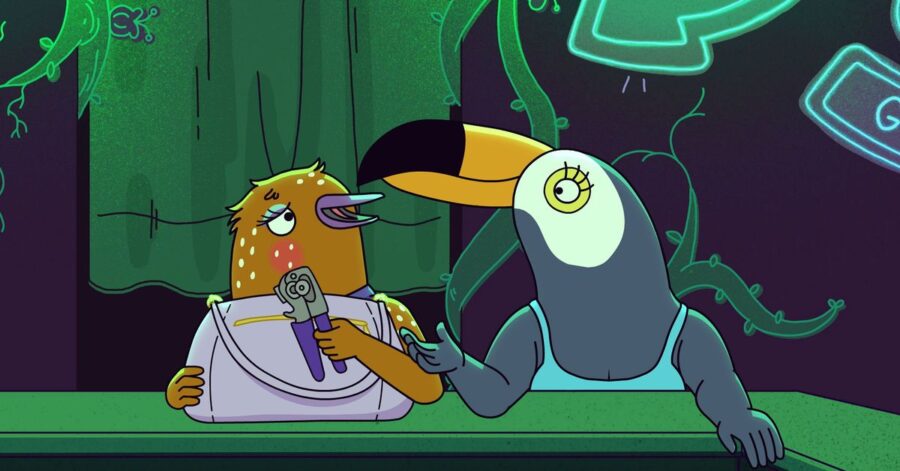Netflix’s decision to cancel Lisa Hanawalt’s animated series Tuca & Bertie after its premiere season was disappointing and more than a little confusing. The show was just so good. It perfectly captured millennial ennui, striking a strong generational chord for those of us who work 70-hour weeks on gig-economy jobs, only to forgo health insurance to afford rent. The show resonated for those of us with mental illness, and those of us who fear commitment and intimacy in the digital age. Best of all, the show focuses on women, a pair of bird best friends whose messy lives feel like a breath of fresh air.
This was before Netflix started sharing its “Top 10” reel, giving access to slightly more decisive metrics of popularity. So it’s difficult to say how popular the show was among subscribers. But given Hanawalt’s work on the popular Netflix animated show Bojack Horseman — along with her ability to capture how disaffecting it can feel to be alive — Tuca & Bertie felt like a perfect match for Bojack’s familiar animation style and offbeat humor. Hanawalt’s focus on millennial women seemed like a chance to appeal to new, broader audiences. In the show’s second season, airing at its new home on Cartoon Network’s Adult Swim block, the series cements its status as one of the funniest, most nuanced sitcoms exploring modern female friendship.
Before Tuca & Bertie, I never thought an animated show might dare not only to focus on millennial women, but to draw comedy from taboo issues like workplace harassment, STIs, mental illness, sobriety, and sexual assault. Women are underrepresented in animation, especially women of color, making these kinds of stories rare. (This also extends to children’s media.) The 2010s popularized messy women in television, and when Tuca & Bertie launched in 2019, it tackled these subjects with startling nuance. It’s also extraordinary that Ali Wong and Tiffany Hadish were cast as the series’ lead voice actors, given that that run of messy women tended to be white. (Except in Broad City, which critics have compared Tuca & Bertie to.)

Hanawalt’s signature sense of gonzo humor allowed season 1 to tackle difficult subjects, without the layer of uncomfortable dramatic irony and earnest cringe that can make a show like Bojack so hard to watch. Mostly, Tuca & Bertie punched up at systems that perpetuate harm, rather than down on the people victimized by those systems — unlike early-’00s animated sitcoms, which simply made fun of people who suffered misfortune, or glorified abusive characters.
Season 1 of Tuca & Bertie is stuffed with bizarre, raunchy, sometimes disturbing jokes (like the giant sex bugs) that give its viewers permission to laugh with Tuca and Bertie, rather than at their expense. An early episode lambasts workplace harassment by bringing one of Bertie’s boobs to life after a coworker makes an objectifying comment. (It pops off her body and takes the day off.) Tuca’s misadventures in the gig economy are bleakly funny, even portentous — her online sex work brings OnlyFans to mind, and when she tries to treat a tumor-like growth with a garlic-based home remedy, it’s hard not to sympathize, since healthcare is so maddeningly expensive. The show also captures the late-stage capitalist cognitive dissonance between what women have been told will make us happy, and what actually does, like when Bertie finally gets her promotion, only to find it simply means more work.
The show offers a particularly sharp commentary on sexual misconduct and assault. One of the major plotlines has Bertie chasing her creative dream (a “side hustle,” basically) where she apprentices to a big-name baker, Pastry Pete. He manages her with a familiar combination of innuendo and intimidation. The show trusted its viewers to understand the gray area of fear and unwanted sexual attraction, and the way people in power can use sexual aggression to manipulate and cast shame on victims.
Season 2 expands on these themes of female friendship, anxiety, grief, and power. The four episodes of season 2 provided for critics are just as funny as season 1, seamlessly transitioning Bird Town to a new network. There’s a lot of comedy in the catastrophizing that can come with anxiety. Hanawalt lives with anxiety herself, which gives her an expert grasp of what it means to logically understand the symptoms, while feeling powerless to actually manage them. Again, the show is extremely specific about its approach, with plotlines around the difficulty of finding a good therapist. Paired with Tuca’s chaotic antics, there are ample opportunities for the most ridiculous outcomes.
But the new season also treads into more serious territory, in line with the melancholic, emotionally affecting final episodes of season 1. Season 2 delves into Tuca’s character development, rather than mostly relying on her as a comedic foil. This season, she grieves over her mother’s death and deals with insomnia. The show flips the script on Tuca and Bertie’s friendship, positioning Tuca as a caretaker. Tuca’s fear of romantic commitment is contextualized by a fear of not being there for her best friend: Bertie’s boyfriend Speckle, for all his good intentions, doesn’t really know how to talk her off the ledge. Hanawalt also focuses on Tuca’s sobriety, which feels especially topical, given how the pandemic made staying sober even more difficult.
Season 2 takes great advantage of the sitcom storytelling format, in which characters “reset” at the start of each episode, while building out a greater emotional throughline that allows them to grow and evolve. Tuca & Bertie’s self-contained episodes give it space to play with setting, introducing “nighttime” Bird Town as well as Planteau, a horror-tinged, flora-dense locale that could have sprouted from the mind of Jeff VanderMeer. The show also plays with comedic violence and weirdness, a bit like Archer giving viewers permission to laugh when Lana shoots Archer in the foot. Viewers know he’ll be fine, just as we know Speckle won’t be high on hallucinogens forever. (What abides in Planteau resides in Planteau!)

But Tuca & Bertie’s second season also firmly plants it in the ranks of animated shows that find a form of realism by turning a mirror to their characters’ traumas. It’s reminiscent of other WarnerMedia shows, like Adult Swim’s Rick and Morty reckoning with seeing themselves die, or Cartoon Network’s excellent epilogue series Steven Universe Future, in which a teenage Steven Universe deals with years of pent-up emotion. That said, the thoughtful handling of trauma has always been Tuca & Bertie’s strong suit. By the end of season 1, viewers came to understand Tuca’s center-of-attention energy as a way of coping with the immense grief of losing a single parent, and Bertie’s anxiety as part of the trauma of being sexually assaulted as a child.
Season 2 digs deeper into the idea that managing trauma is a lifelong project. In Bertie’s case, it’s discovering Pastry Pete wasn’t actually disgraced after Tuca’s footage of him grabbing and threatening to “ruin” Bertie went viral. He’s as popular as ever, and selling a new line of bullshit apologia-themed pastries. It’s a natural extension of season 1’s focus on sexual misconduct, giving a timely commentary on “cancel culture” and the way men credibly accused of sexual abuse still easily hold positions of power and influence. For Tuca, it’s learning to live with grief and to trust that she doesn’t have to be the glue or the savior to those she holds dear — a role she had to take on in the wake of her mother’s death.
But the episodes are by no means dour. There are still incredible antics and lighter moments: skinnydipping and tomato-headed strippers and a universe where birds are people, but there are also separate, smaller, truly birdlike birds. The show’s characters still feel so real, even though they’re deeply caricatured. There’s immense comfort in catching up with these beloved favorite characters, in a show that still understands how laughing and crying are never too far apart.
Polygon – All
Source link
Related Post:
- Razer Anzu Smart Glasses Review | Smart Enough For The Price Tag?
- Review: Ambition: A Minuet in Power Attempts to Be Daring
- PlayStation Studios Boss: I Encourage Our Teams to Be Fiercely Daring
- Never Have I Ever season 2 review: Mindy Kaling’s back with cringe and sincerity
- Cris Tales Review In-Progress: A Smart, Gorgeous RPG
- Gears Triple Bundle Is Now Available For Windows 10, Xbox One, And Xbox Series X|S (Xbox Play Anywhere And Smart Delivery)
- EA and Internet Matters launch Play Together/Play Smart campaign
- Warhammer Plus is a stand-alone streaming app for mobile and smart TVs
- This New Nintendo Switch Case Offers A Smart Way To Store And Protect Your Console
- Call of Duty: Warzone’s first ever exclusive perks arrive with Season 5
